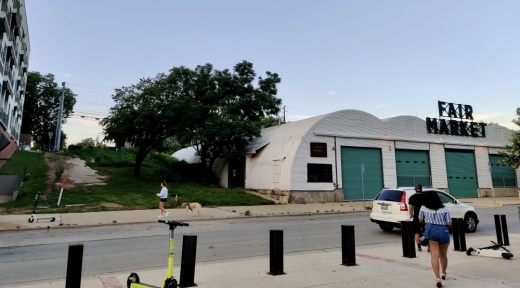The conditional rezoning of several East Austin properties, including the Fair Market venue's home at 1100 E. Fifth St., Austin, was forwarded to City Council by members of the commission earlier this week. Along with the rezoning, commissioners approved sending along an associated adjustment to the East Cesar Chavez/Plaza Saltillo Transit Oriented Development Station Area Plan; both items would grant the planned development an additional 25 feet of height allowance.
Property owner Montwalk Holdings Ltd.'s proposal for redevelopment covers the existing Fair Market space as well as 1100 and 1108 E. Fifth and 502 and 504 Waller streets. The plan centers around a six-story office building with ground-floor retail space and underground parking. Restoration of the undeveloped, city-owned Roy and Matias Velasquez Plaza just west of the building would also be included in the Montwalk plan if approved by City Council.
Speaking on behalf of Montwalk at the July 13 meeting, Armbrust & Brown attorney Richard Suttle said the development is seeking additional height to take advantage of the area's transit-oriented development, or TOD, bonus for building density. With a six-floor plan at a maximum of 85 feet, if approved, he said a contribution of between $900,000 and $1 million to the city's affordable housing programs is expected.
"We’re not trying to poke up in the middle of the TOD. ... What we want to do is try to take advantage of the density bonus program and pay into the affordable housing trust fund to basically get an extra floor of height on this building and allow us to do modern floor-to-ceiling heights," Suttle said. “This won’t be out of place at all and meets the planning principles of density in and around a TOD.”
The proposal received some opposition from area residents calling into the meeting, who said the development would not be providing the neighborhood with major enhancements in line with its alteration of local plans limiting building height at 60 feet.
"The request for 25 additional feet at this location, it’s just been hard for us to find any common ground with the applicant to understand how it actually meets the neighborhood goals, how it actually makes a difference for the community of people who are already here," said Kristen Heaney, chair of the East Cesar Chavez Neighborhood Contact Team.
Planning commissioners were also split on various aspects of the project, with several supporting the construction of a large office space in a transit-friendly area already home to a MetroRail station and bikeway that is located blocks from I-35. However, concerns were also raised about the scope of the building's parking space given those other mobility options and whether Velasquez Plaza can remain an open community space without being overtaken by extensions of the proposed development.
Suttle said that for the time being, the several floors of underground parking remain a "necessary evil" for new developments coming up in Austin, although they may be reduced as the project is finalized. He also expressed a willingness by the development team to sign onto restrictive agreements relating to the public plaza's use to ensure it remains fully accessible.
"We’re turning what was essentially a street into a pocket park or a green space," Suttle said. "It will be a spot for both our project and the project next door to be able to communicate with one another through the green space, but it’s also an area where folks will be able to transverse between Fifth and Sixth [streets] and through the neighborhood. ... It won’t be walled or fenced off; it’ll be open and inviting."
Commissioners' vote for a two-week postponement to allow those issues to be further workshopped failed 5-3, leading to a 7-1 vote in favor of sending the rezoning and local plan amendment to council without a formal recommendation. Commission Vice Chair Claire Hempel voted against.





